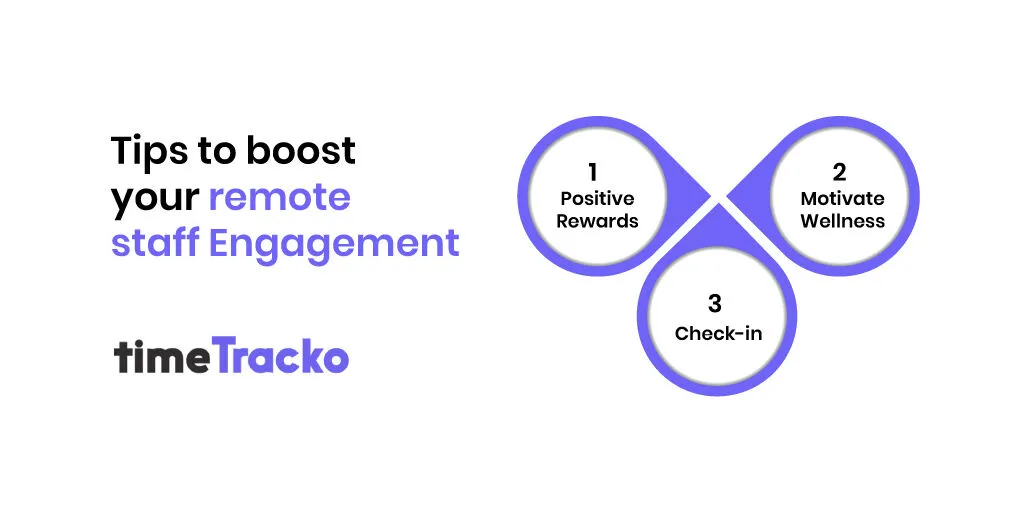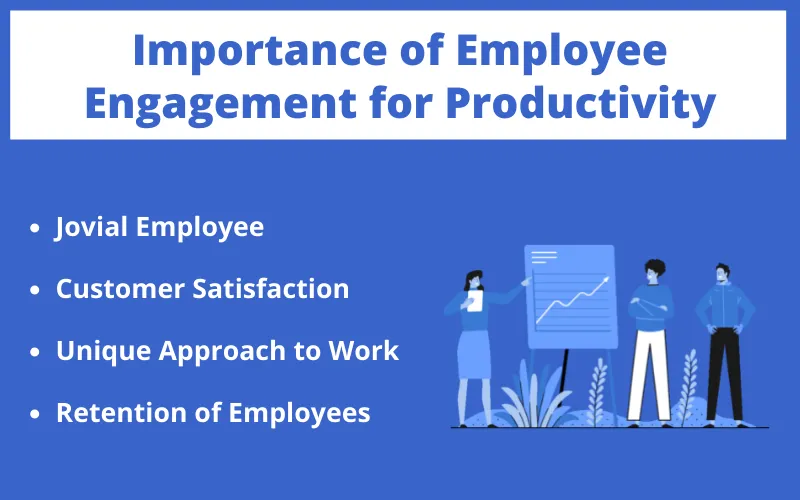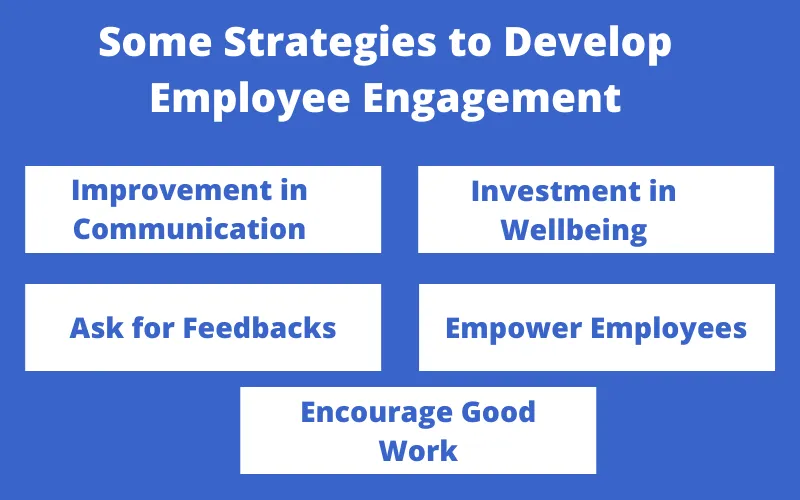Impact of Employee Engagement on Productivity
Impact of Employee Engagement on Productivity
Employee engagement is a notion that states the extent to which an employee is conducting work with enthusiasm and interest to deliver fruitful outputs.
It is directly related to work productivity as when there is more employee engagement, there is more outcome.
When employees are motivated, they have a better employee experience and work harder, which has a huge positive impact on the business.
Employee engagement also denotes work satisfaction and is a factor that encourages workers to work efficiently.
Every worker in the office wishes to be involved in their respective works and develop an emotional connection and a sense of community with workmates helping to improve employee engagement.
The sense of belonging is not enough. They may be present at work but do not give their hundred percent, and employee engagement and employee productivity decrease despite good relations and trust in remote teams.

What is Employee Engagement?
The employee engagement approach includes motivating employees to commit to their work duties and conduct day-to-day responsibilities easily and without any doubts or objections, remembering organizational values and goals.
The level to which one employee is engaged in work may not match up to the level of engagement of another employee.
This mismatch between engaged workers is the reason why some members of a team are highly motivated and productive while others require a push of encouragement and motivation.
Employee engagement includes employee happiness, job satisfaction, and proper employee communications.
Employee Engagement vs. Commitment vs. Relations
Commitment relates to the level of satisfaction an employee has with the organization. Employee engagement refers to the extra work or effort with the will and desire to meet the goals set up by the institution on employees as assignments or duties.
The relation between employee engagement and employee relations is direct as the more employees are engaged, the better the relations flourish among the workers. Positive and constructive employee relations help to achieve goals in a team easily.
Productivity and Employee Engagement
Organizations with a highly engaged population succeed more than those lacking employee engagement and have lazy employees.
In comparison, the firms that take positions in the top quartile have a lower absenteeism rate. The difference between a top-quartile and a bottom-quartile company is the impact of employee engagement.
When employee engagement increases, the quality of health among workers also improves, leading to more productivity.
Engaged employees pay attention to work and keep an eye on the team’s needs and overall company. Implementation of a productivity plan can help employees focus on work.
The employee journey is smooth when they are engaged in work and are equally productive.
Importance of Employee Engagement for Productivity

When an office focuses too much on results and forgets about the situation of employees and workplace culture, then productivity decreases.
There should be some concern about driving employee engagement and about the situation of employees and how actively they are performing their respective jobs and engaging in the workplace.
When the entire team has large employee engagement, employees are happy and excited for more work.
Employee engagement is essential for the following reasons:
Jovial Employee
Employee job satisfaction is one of the important factors to consider concerning employee engagement. When employees are content with their job, they are happy and joyous and love to do their work.
Each employee’s happiness develops a positive organizational culture, which leads employees to work harder to achieve institutional goals and improve employee communication.
Jovial employees come up with brighter ideas to fill loopholes in the team leading to better productivity.
Customer Satisfaction
Employees are the front lines of a company. When employees are taken care of properly, then that is how they will take care of the customers.
When an employee is engaged, then they represent your organization better. Customer satisfaction is measurable using different CRM ( Customer Relationship Management ) Tools.
Customers are important for deriving revenues, and when engaged employees provide better services, sales automatically go up, helping the organization grow toward success and productivity.
Unique Approach to Work
Monotonous routines are tiring, and task repetition leads to employees’ disengagement.
For a work routine to not drain employees and remain fresh and lively sometimes, employees need to change their daily routine.
Trying newer processes or approaches in ways that can bring positive results and increase productivity.
New processes can change employees’ goals as they find better ways to cope with old problems and move forward in their careers.
Retention of Employees
An employee’s loyalty depends upon the treatment of employers and the office employee.
The employees who remain in an organization for a longer time are assets. It is better when every employee stays loyal and works in your organization for a longer duration.
Some traits of highly productive employees are:
- Employees are seriously engaged in work.
- Employees have served the organization for more than a decade.
- Their job roles perfectly match their skills and caliber.
Job providers have to adjust workloads and provide incentives to increase employee engagement. Measured employee engagement will encourage employees to remain in the same company longer.
Factors Affecting Employee Engagement
Employee engagement requires passion and dedication to work. Employees seek more than just incentives or salaries, and employees also demand growth and promotional facilities, and due to the lack of these, many employees flee to other companies.
Some factors affecting employee engagement are:
- Employees’ reliance and faith towards the company and its guidance with leadership is a factor that influences employee engagement. When a company states its goal properly, employees get passionate about work, hear the main goal, and have high productivity.
- Employee relationship with leaders and supervisors is another factor affecting employee engagement. When the lead and other members’ relationship is good, it automatically pushes employees to work harder, enjoys work, and improve employee engagement.
- When an employee is not happy or proud to be a part of a certain company and lacks interest in the overall idea of the company, then there is no chance that the work will turn out good. This situation occurs due to a lack of engagement and productivity.
Communication and Employee Engagement
Communication is an excellent tool to enhance employee engagement for better outputs from the employee’s side.
Here are ways to boost employee engagement using communication:
- The communication chain should be clear, starting from the head of the office, which flows down to other company members leading to business success.
- It is essential to fuse communication with planning for the betterment of individual members of the office. In every decision, it is important to involve employees and their views on certain situations.
- Promoting a healthy environment for better employee communication leads to an effective employee. When employees and employers have friendly relationships, sharing everything that helps with employee engagement is easier.
- Reward the top performer and use communication tools if the work is internal, and communicating with members other than the office can make you realize how good the company you are working at is.
Some Strategies to Develop Employee Engagement

Improvement in Communication
Improvement in communication is one of the main strategies for employee engagement. Firstly, it is necessary to know why an employee is not engaged and what makes them stay away from responsibilities.
It is possible for employees themselves to not know about their engagement in work. For this situation, an employee should ask for lack of concentration and interest at work.
This communication point can work out as a turning point for employees’ eagerness for work.
Investment in Wellbeing
Employee wellbeing leads to better employee engagement. When an employee is completely dedicated to working, but the employer doesn’t care about employee wellbeing, the employee gets burnt out, staying away from the company’s goal.
Burning out due to work leads to lesser employee engagement. Absenteeism and presenteeism increase due to a decrease in employee engagement.
When a company invests in employee wellbeing, then the quality of health of employees increases.
Ask for Feedbacks
It is always better to seek employee feedback to work proficiently. The tools for collecting feedback make it easier to know how everyone thinks of something.
The taking of feedback can bring revolution to the company as honest feedback highlights the good with bad habits and processes, setting up a room for improvement and increasing chances for employee engagement.
Empower Employees
When micromanagement, employees feel controlled and hesitate to set themselves free for work.
Eradicating micromanagement includes empowering employees, increasing engagement levels, and understanding that the purpose of work is results and employee engagement.
Encourage Good Work
How often are good works recognized and encouraged in your company? One of the ways to increase the engagement of employees is by rewarding and praising the efforts of a team or a hard worker.
Rewarding and recognizing an employee raises the other employees to continue good work and reach company goals and objectives.
The culture of encouraging good work will uplift the members to perform better and continue the good work.
Employee branding is another option to make present employees happy and attract new employees.
Management of Employee Engagement for Productivity
To keep employees’ productivity high, some measures for managing employee engagement are essential.
Some of the ways to manage the engagement of employees by focusing on the employee are:
Conduct Surveys
When engagement surveys are conducted regarding employee engagement and wellbeing, employers can understand the present situation of the employees.
Employee Turnover Rates
Employee turnover rate is another strong metric that provides insights into employees’ engagement in the company.
If the company’s employee turnover rate is too high than the benchmark, then it is obvious that other employees also lack the zeal to work.
Analyze the Data
After receiving data from analysis and calculation, it is better to analyze the present and past results and derive conclusions by looking at the data and information.
Employee Net Promoter Score
The employee net promoter score measures how employees in your office feel about your company, including the remote team. A lot of ideas are derivable from the result of this score.
Conclusion
The impact of employee engagement on productivity is very high, and engaged organizations can sit together and discuss the employees’ work situation and how they can get much productivity by reassuring the happiness, health, and wellbeing of employees.

 in Melbourne
in Melbourne 
 Employee Screen Monitoring Software
Employee Screen Monitoring Software App and Website Monitoring Software
App and Website Monitoring Software Time and Attendance Software
Time and Attendance Software Finance
Finance Banking
Banking Healthcare
Healthcare Lawyers
Lawyers Retail & ecommerce
Retail & ecommerce Knowledge base
Knowledge base Blogs
Blogs Installation Guide
Installation Guide FAQs
FAQs About
About Media Kit
Media Kit Contact us
Contact us